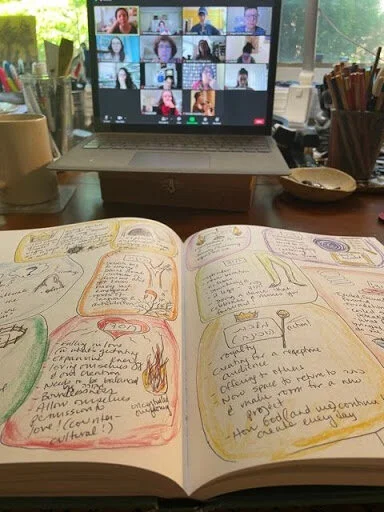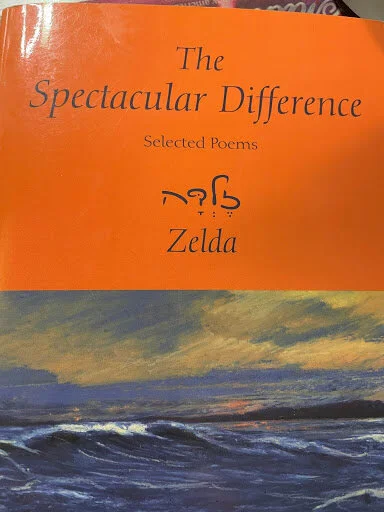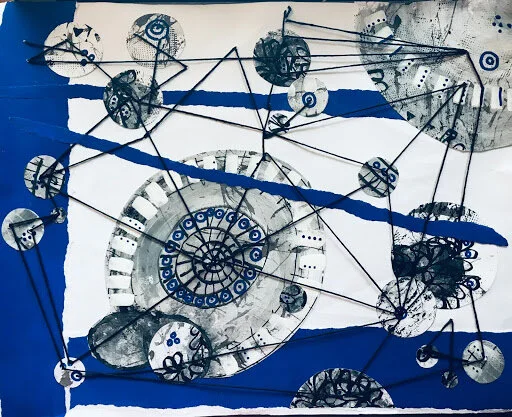Blessed are You in Your Coming In and Your Going Out:
Sheltered Under the Wings of Shechina / Debra Cantor
“Blessing chair” surrounded by “wings” of Shechina. The chair is accompanied by a triptych of collages, featuring chairs of varying numbers: 2 (havruta), 3 (mezuman), and then 10 (minyan), along with related blessings/hopes as we emerge and re-connect.
Project in process
I was nourished by...inspiration from the group; working with my havruta/partner, Naomi; going deep, using poetry, mindfulness, making with new materials; exploring the interplay between the Sefirot and the creative process; cheering each other on! Mind mapping...Zelda...seeking connections...tefillah...weaving ideas...Googling...doodling… journaling





Cohort Three of the Atiq Maker Kollel began while we were still largely confined to our homes by the pandemic. Our time together was therefore all spent on Zoom, rather than in person. We met one another from our homes across many time zones, while seated in our chairs. I have been fascinated by the symbolism of chairs for some time. Chairs are familiar objects that can function, artistically, as stand-ins for human beings. What does a single chair say to us? It can imply a presence as well as an absence. There are obvious Jewish connections, such as Elijah’s chair, the empty chair at the Seder, the metaphor of God on the High Holidays enthroned on a kisei ram v’nisah (a high and exalted chair), the lowly stool of a mourner during shiva.
A chair holds us and provides us with comfort, rest, and support. This past year, we spent so much time sitting in our chairs facing screens. I wondered how might we see these chairs as conveyers of blessing, especially as we begin to move back into the world. I imagined that, in place of arms, a chair of blessing might surround a person with the wings of Shechina/God’s indwelling Presence. A chair implies extended commitment to a space/makom. Could a chair also denote a Makom, a holy place?
I decided to make a chair that would help observers focus on their need for comfort during this pandemic year, how they experienced God’s Presence (or yearned for it), and the kinds of blessings they have both received and given.
Prompts for Interaction with The Blessing Chair
When you look at the chair, what feelings does it evoke for you?
During the past year, when have you yearned to be held/comforted/reassured?
In this work, the wings are meant to represent God’s Presence. What does that mean to you?When have you yearned for God’s Presence? When have you felt it?
Now look at the circle of seven blessings in the hamsa/hand (note that this is a traditional symbol of protection across the Middle East.) As you read each blessing, think about the past year. How did you experience this blessing...or not?
How might these blessings help you manage the uncertainty and re-entry of the coming months?
Is there a blessing you feel a special connection with? Is there a blessing you would add?
Prompts for interaction with the Collage Triptych
In these three related collage pieces, the chairs are stand-ins for people and human interaction. How do you feel when you look at them? How do these groupings of chairs stand in contrast to the image of a single chair,and in comparison with one another?
The first collage (with 2 chairs) includes the blessing “michayeh ha-meytim/who brings the dead back to life.” This blessing is recited when you see a dear friend or relative after a year or more. Have you had this experience recently? How does this blessing resonate for you?
The second collage (with 3 chairs) includes the phrase “haverai nivarech/Friends, let us bless,” which is the invitation to Birkat HaMazon/the Grace After Meals. What have you missed about dining with others this year? What are the blessings of eating together?
The third collage (with 10 chairs) represents a minyan, the quorum of Jews needed to recite certain prayers, such as Kaddish. If you are someone who has gone to a synagogue (or other house of worship) in the past, how has it felt to be “exiled” from that place during the pandemic? What have you missed? If you have participated in worship over Zoom, how was that experience different? How might it feel to return to the synagogue, or other communal space, and pray with one another in person again? What makes a makom kadosh, a holy space?









